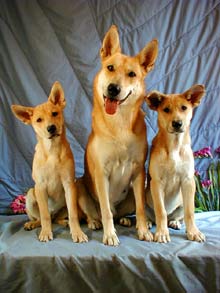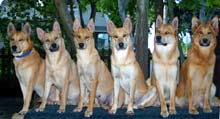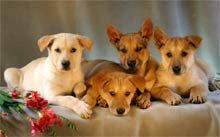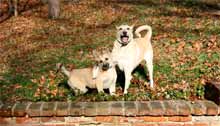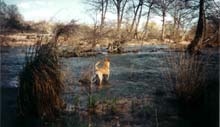|

May 31, 2008
As Sandra Olsen explained in her May cover story, it’s remarkably difficult to tell when and where the horse was first domesticated, in part because the kinds of “skeletal changes that appeared not long after the process began” in other species, such as a shortened muzzle in the dog and smaller horns and body size in cattle, are not detectable in horses till a few thousand years into their domestication. However, the availability of such clues has not much diminished the contentiousness of the debate about the origins of other domesticated species. “[N]o other animal has provoked such contention over the ‘where’ and ‘when’ of its domestication,” Olsen wrote—“[a]part from, possibly, the dog and the pig.”
Intrigued, I looked up the domestication of the dog and the pig. Sure enough, just when you’ve accepted as a virtual certainty that domestic dogs are the direct descendants of East Asian wolves—so much so that many scientists classify them as a subspecies, Canis lupus familiaris—along comes a fellow who plausibly casts doubt on that theory. Darren Naish, a Brit whose blog, like his Ph.D., is titled Tetrapod Zoology, provides an excellent review of the evidence. A taste:
Are domestic dogs really wolves? Some very obvious things to consider[:]

As a rough rule of thumb, the domesticated forms of wild mammal species (1) revert back to wild-type after being feral for a few generations, and (2) readily interbreed with their wild ancestors. If domestic dogs are wolves, then the many populations of feral dogs that live world-wide should theoretically have reverted back to being wolf-like in appearance and behaviour. But they haven’t. Instead, domestic dogs always end up looking like pariah dogs—the relatively small (11–16 kg), socially flexible semi-domesticated and feral dogs of the Old World tropics. . . .

Archaeological data shows that pariah dogs have a stable history, with dog skulls from 4000-year-old deposits in Thailand being essentially identical to the modern dingo-like pariah dogs of the area. Until relatively recently, domestic dogs must have been free-ranging and hence would have had ample opportunity to interbreed with wolves. While this has certainly happened on many occasions (modern wolf/dog hybrids are known from North America, Italy, as well as from archaeological samples), what is surprising is that it hasn’t happened more often. This isn’t the case in other domesticated mammals, where interbreeding with wild ancestors is widespread. . . .

[Even where they have opportunities to interbreed, w]olves and domestic dogs are in fact staying distinct.
And that’s just the beginning. You won’t look at your dog quite the same way after reading this—especially if he’s one of those countless shelter mutts who look quite a bit like a pariah dog.

THE PLOT THICKENS: Evidence was published in Science in 2002 that “when the first Americans arrived in the New World at least 12,000 years ago, these hunter-gatherers already brought domesticated dogs with them. However, those ancient dogs apparently have not contributed their genes to modern dogs.” Well, here is a breed called the Carolina Dog, or “Dixie Dingo,” which, its breeders assert, represents a direct survival of those ancient companions:
The Carolina Dog comes out of the American Deep South and is thought to be a direct descendant of the ancient pariah dogs that accompanied Asians across the Bering Straits land bridge 8,000 years ago. . . . The Carolina Dog was discovered and named by Dr. I. Lehr Brisbin, Jr., a biology professor at the University of Georgia, at the United States Department of Energy’s Savannah River site in South Carolina [who further claims to know that the dog was domesticated “over 11,000 years ago in the Shanidar Cave region of Iraq” —ed.]. This is a remote area from which the public has been excluded, and wild dogs that have lived there for centuries have had little opportunity to breed with domestic dogs. Brisbin noted that these dogs were almost identical in looks to the Dingo. Other scientists observed that the Carolina’s bone structure was very similar to the remains of the neolithic dog bones from Native American burial sites thousands of years old. . . . Down South, the Carolina Dog is affectionately named “Old Yaller” because of his yellow color.
The National Geographic Channel produced a 2003 television documentary called “Search for the First Dog” that featured the Carolina Dog. What the breed descriptions don’t say is whether the mitochondrial DNA of the Carolina Dog has ever been compared to the DNA extracted from those ancient domestic dog bones from archaeological sites. Brisbin, too, is interested in the question of whether pariah dogs really are descended from Canis lupus or perhaps from “the Simien Wolf (Canis simensis) of North Africa and the Dhole [Cuon (now Canis) alpinus] of the Indian subcontinent of southeast Asia.”
Confused yet?
Well, what about the pig? Equally confusing. It seems that wild boars may have been independently domesticated multiple times, in different places. This is fascinating stuff, because once a species or a genus is domesticated, the migration, divergence, and confluence of its genes shed new light on the ancient activities and movements of humans. And yet it seems as if every new discovery or theory only feeds the flames of controversy by raising more questions than it answers.
Watch for an exchange of letters in our next (July-August) issue that reveals one of the politely seething controversies in horse-domestication research: whether a certain kind of wear on certain teeth of certain horse skulls could have natural causes (as Sandra Olsen maintains), or whether it could only come from the abrasion of a rider’s bit (the theory of David W. Anthony and Dorcas Brown).


(Annie Gottlieb) |
Comments (add yours!)

Return to May home
|



